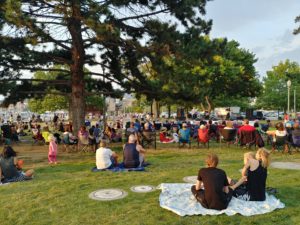Continuing our presentation of urban agendas that operationalize urban systems theory…
Apart from the prevalent sustainable city agenda, at least five other popular urban agendas have been identified in the literature: ecocity, low-carbon city, resilient city, knowledge city, and smart city. The green city and the livable city also briefly appear but are conceptually considered as satellites of ecocity and sustainable city respectively; similarly, healthy city and just city appear as variants of the sustainable city. Contrary to common perceptions among policy-makers, the various agendas are not all based on the same theoretical foundations and their terms should not be used interchangeably.
Ecocity and green city, grounded in decades-old principles of deep ecology and the humanities, gained momentum in the late 20th century and were operationalized mainly within a broader eco-urbanism movement. Eco-districts, Zero-carbon city, and Low Impact Urban Developments are similar approaches that seek to address sustainability within a spirit of collectiveness.
Smart and digital city agendas seem to prioritize the use of digital technology and infrastructure to increase well-being, along with an increased focus on governance. However, the smart city agenda in practice tends to not include holistic sustainability approaches in that related initiatives may not address social equity or ecologically responsible resource management. Bibliometric and webometric analyses additionally showed that there is not a widely accepted definition or coherent understanding of the smart city agenda, thus potentially leading to tensions and disconnect in research, policy, and practice.
The resilient city agenda in practice emerged before Alberti et al. and Godschalk first defined the concept of urban resilience and before Ostrom and the Resilience Alliance introduced their SES framework. It was for instance a key driver of the UK Transition Town movement which encourages communities to reduce carbon emissions, prepare for a post-peak oil economy, and ultimately transition to sustainable systems. As of January 2020, more than 950 towns across the world participated in the movement. The resilient city concept has more recently been operationalized through the 100 Resilient Cities network pioneered by the Rockefeller Foundation and based on the City Resilience Framework.
The ubiquitous city focuses on eco-efficient and energy-efficient technologies, and local circularity and the compact city agenda prioritizes efficient land use, lower service cost, and high productivity and social life. Critics of such eco-urbanism agendas posit that green infrastructure is developed only for wealthy inhabitants, turning such places into “ecological security” or “ecological gentrification” zones that largely fail to address social issues.
The compact city caters to all sustainability pillars more than other agendas and cities around the world have applied its principles of compactness and high density. It presents many benefits (e.g., reduced greenhouse gas emissions and increased safety and economic productivity), but also potential challenges to be dealt with (e.g., inadequate green space, reduced housing affordability, traffic congestion if not coupled with robust public transit infrastructure, and possible difficulties in tackling health crises like the 2020 pandemic).
Yet, how do decision-makers choose one urban agenda over another? The main decision-making driver seems to revolve around trade-offs depending on the city’s needs, context, and aspirations. It is impaired though due to internal issues, such as NIMBYism (“not in my back yard”), lack of sufficient resources and political will, and community fragmentation, and external threats, such as inter-city competition and climate change impact. Many local governments, particularly in cities with global outlook or narrative, turn to their national government and the private sector for partnerships in technology and innovation as the panacea for all urban challenges, hence the rapid emergence of the smart city and resilient city agendas.

Bibliography
Ahlfeldt, G., & Pietrostefani, E. (2017). The effects of compact urban form: A qualitative and quantitative evidence review. InOECD Working Papers(OECD Working Papers). https://doi.org/10.1787/bbea8b78-en
Baker, S., & Mehmood, A. (2015). Social innovation and the governance of sustainable places.Local Environment,20(3), 321–334. https://doi.org/10.1080/13549839.2013.842964
Beatley, T. (2017). Biophilic cities and healthy societies.Urban Planning,2(4), 1–4. https://doi.org/10.17645/up.v2i4.1054
Berke, P. R. (2002). Does Sustainable Development Offer a New Direction for Planning? Challenges for the Twenty-First Century.Journal of Planning Literature,17(1), 21–36. https://doi.org/10.1177/088122017001002
Chelleri, L. (2012). From the «Resilient City» to Urban Resilience. A review essay on understanding and integrating the resilience perspective for urban systems.Documents d’Anàlisi Geogràfica,582, 287–306. https://doi.org/10.1007/978-3-642-29470-9_2
Cowley, R., Joss, S., & Dayot, Y. (2018). The smart city and its publics: Insights from across six UK cities.Urban Research & Practice,11(1), 53–77. https://doi.org/10.1080/17535069.2017.1293150
De Jong, M., Joss, S., Schraven, D., Zhan, C., & Weijnen, M. (2015). Sustainable-smart-resilient-low carbon-eco-knowledge cities; Making sense of a multitude of concepts promoting sustainable urbanization.Journal of Cleaner Production,109, 25–38. https://doi.org/10.1016/j.jclepro.2015.02.004
Hassan, A. M., & Lee, H. (2015). The paradox of the sustainable city: Definitions and examples.Environment, Development and Sustainability,17(6), 1267–1285. https://doi.org/10.1007/s10668-014-9604-z
Hodson, M., & Marvin, S. (2010). Urbanism in the anthropocene: Ecological urbanism or premium ecological enclaves?City,14(3), 298–313. https://doi.org/10.1080/13604813.2010.482277
Joss, S., Sengers, F., Schraven, D., Caprotti, F., & Dayot, Y. (2019). The Smart City as Global Discourse: Storylines and Critical Junctures across 27 Cities.Journal of Urban Technology,26(1), 3–34. https://doi.org/10.1080/10630732.2018.1558387
McGinnis, M. D., & Ostrom, E. (2014). Social-ecological system framework: Initial changes and continuing challenges.Ecology and Society,19(2). https://doi.org/10.5751/ES-06387-190230
Meerow, S., Newell, J. P., & Stults, M. (2016). Defining urban resilience: A review.Landscape and Urban Planning,147, 38–49. https://doi.org/10.1016/j.landurbplan.2015.11.011
Moore, J., Miller, K., Register, R., & Campbell, S. (2017).International Ecocity standards.
Mora, L., Bolici, R., & Deakin, M. (2017). The First Two Decades of Smart-City Research: A Bibliometric Analysis.Journal of Urban Technology,24(1), 3–27. https://doi.org/10.1080/10630732.2017.1285123
Neuman, M. (2005). The Compact City Fallacy.Journal of Planning Education and Research,25(1), 11–26. https://doi.org/10.1177/0739456X04270466
NYU Marron Institute, & 100 Resilient Cities. (2018).100RC Handbook: Planning for Resilient Urban Growth.
Roseland, M. (2012).Toward Sustainable Communities: Solutions for Citizens and Their Governments(4th ed.). New Society Publishers.
Roseland, M., & Spiliotopoulou, M. (2016). Converging Urban Agendas: Toward Healthy and Sustainable Communities.Social Sciences,5(3), 28. https://doi.org/10.3390/socsci5030028
Sharifi, A. (2016). From Garden City to Eco-urbanism: The quest for sustainable neighborhood development.Sustainable Cities and Society,20, 1–16. https://doi.org/10.1016/j.scs.2015.09.002
Transition Network. (n.d.). https://www.transitionnetwork.org/

















